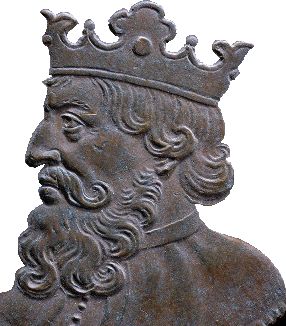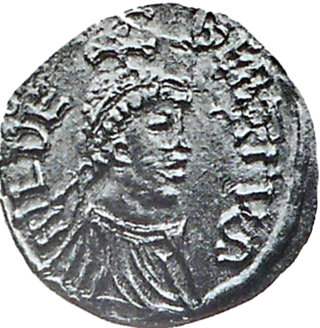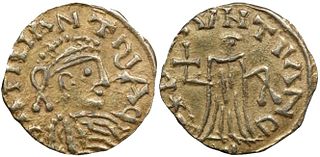
Year 561 (DLXI) was a common year starting on Saturday of the Julian calendar. The denomination 561 for this year has been used since the early medieval period, when the Anno Domini calendar era became the prevalent method in Europe for naming years.

Gregory of Tours was a Gallo-Roman historian and Bishop of Tours during the Merovingian period and is known as the "father of French history." He was a prelate in the Merovingian kingdom, encompassing Gaul's historic region.

Clotilde, also known as Clothilde, Clotilda, Clotild, Rotilde etc., was a Queen of the Franks. She was supposedly descended from the Gothic king Athanaric and became the second wife of the Frankish king Clovis I in 493. The Merovingian dynasty to which her husband belonged ruled Frankish kingdoms for over 200 years (450–758).

Austrasia was a territory which formed the north-eastern section of the Kingdom of the Franks from the 6th to 8th centuries, ruled by the Frankish Merovingian and Carolingian dynasties during the Early Middle Ages. It was centred on the Meuse, Middle Rhine, and the Moselle rivers, and was the original territory of the Franks, including both the so-called Salian Franks and Ripuarian Franks, which Clovis I, King of the Franks (481–511) conquered after first taking control of the bordering part of Roman Gaul, which is sometimes described in this period as Neustria.

Chlothar II, sometime called "the Young", was king of the Franks, ruling Neustria (584–629), Burgundy (613–629) and Austrasia (613–623).

Neustria was the western part of the Kingdom of the Franks during the early middle ages, in contrast to the eastern Frankish kingdom, Austrasia. It initially included land between the Loire and the Silva Carbonaria, in the north of present-day France, with Paris, Orléans, Tours, Soissons as its main cities. The population was therefore originally largely Romanised.

Chilperic I was the king of Neustria from 561 to his death. He was one of the sons of the Frankish king Clotaire I and Queen Aregund.

Chlothar I, sometime called "the Old", also anglicised as Clotaire, was a king of the Franks of the Merovingian dynasty and one of the four sons of Clovis I.

Childebert I was a Frankish King of the Merovingian dynasty, as third of the four sons of Clovis I who shared the kingdom of the Franks upon their father's death in 511. He was one of the sons of Saint Clotilda, born at Reims. He reigned as King of Paris from 511 to 558 and Orléans from 524 to 558.

Jean Charles Léonard de Sismondi, also known as Jean Charles Leonard Simonde de Sismondi,, whose real surname was Simonde, was a Swiss historian and political economist, who is best known for his works on French and Italian history, and his economic ideas. His Nouveaux principes d'économie politique, ou de la richesse dans ses rapports avec la population (1819) represents the first liberal critique of laissez-faire economics. He was one of the pioneering advocates of unemployment insurance, sickness benefits, a progressive tax, regulation of working hours, and a pension scheme. He was also the first to coin the term proletariat to refer to the working class created under capitalism, and his discussion of mieux value anticipates the concept of surplus value. According to Gareth Stedman Jones, "much of what Sismondi wrote became part of the standard repertoire of socialist criticism of modern industry," earning him critical commentary in the Communist Manifesto.

The Kingdom of the Franks, also known as the Frankish Kingdom, the Frankish Empire or Francia, was the largest post-Roman barbarian kingdom in Western Europe. It was ruled by the Frankish Merovingian and Carolingian dynasties during the Early Middle Ages. Francia was among the last surviving Germanic kingdoms from the Migration Period era.
Fredegund or Fredegunda was the queen consort of Chilperic I, the Merovingian Frankish king of Soissons. Fredegund served as regent during the minority of her son Chlothar II from 584 until 597.

Charibert I was the Merovingian King of Paris, the second-eldest son of Chlothar I and his first wife Ingund. His elder brother Gunthar died sometime before their father's death. He shared in the partition of the Frankish kingdom that followed his father's death in 561, receiving the old kingdom of Childebert I, with its capital at Paris.

Saint Gontrand, also called Gontran, Gontram, Guntram, Gunthram, Gunthchramn, and Guntramnus, was the king of the Kingdom of Orléans from AD 561 to AD 592. He was the third-eldest and second-eldest-surviving son of Chlothar I and Ingunda. On his father's death in 561, he became king of a fourth of the Kingdom of the Franks, and made his capital at Orléans. The name "Gontrand" denotes "War Raven".
Ingonde, Ingund, Ingunda, or Ingundis was a queen of the Franks by marriage to Clotaire I, son of Clovis.
Ansbert was a Frankish Austrasian noble, as well as a Gallo-Roman Senator. He is thought to be the son of Ferreolus, Senator of Narbonne and his wife, Dode. This would make him the great-grandson of Tonantius Ferreolus, Praetorian Prefect of Gaul and his wife Papianilla.
Conomor, also known as Conomerus or Conomor the Cursed, was an early medieval ruler of Brittany. His name, which has the Welsh cognate Cynfawr, means "Great Dog", but could also indicate "Sea Dog" in early Brythonic. Conomor was notorious for his cruelty, becoming a legendary villain in Breton culture. He is widely regarded as one of the probable sources for the myth of Bluebeard and possibly also of Tristan's uncle King Mark of Cornwall. The wife-beating giant Cormoran may also retain a garbled folk memory of the same character.

The Menhir de Champ-Dolent is a menhir, or upright standing stone, located in a field outside the town of Dol-de-Bretagne. It is the second largest standing stone in Brittany and is over 9 metres high.
Austregilde, also called Austerchild,Austregildis,Bobilla,Bobile, and Austrechild in most contemporary works and scholarship, was a Frankish queen consort of the Burgundy region in the 6th century. As a woman of the Merovingian elite, Austregilde held a fairly large amount of power, yet this power was limited by Salic law and societal values. As a result, Austregilde and other women needed to exercise their power indirectly through others or through intrigue tactics to become active political players. Understanding Austregilde, the power of elite women and the nature of Merovingian rule requires an analysis of the limited sources available from the contemporary period, like that of the Histories of Gregory of Tours, as well as an understanding of the context surrounding Merovingian rule.
Cautinus was a bishop of the Diocese of Clermont in the 6th century.
















